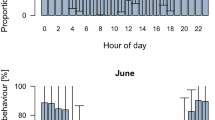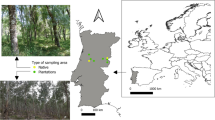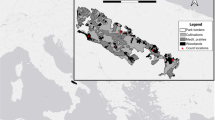Abstract
Increasing wild boar (Sus scrofa L.) population densities all over Europe cause severe economic problems. In popular belief, the wild boar is a more or less diurnal species, causing only minor problems when undisturbed, but is assumed to become nocturnal and wide-ranging when opposed to hunting pressure. In our study, we investigated the impact of hunting and several environmental factors on movements, spatial utilisation and activity patterns by radiotelemetry. Activity pattern revealed a mean proportion of diurnal activity of 12% of all localisations with a monthly change. The wild boar showed increased diurnal activity on undisturbed feeding habitats, especially in early summer. Different hunting methods did influence activity and spatial utilisation in terms of activity and smaller home ranges in areas with only single hunt, although this might be biased by seasonal effects. Flight distances increased significantly after single hunt and capture incidents, but still ranged inside the annual home ranges. Battues did not influence the spatial utilisation before and after hunt significantly. In only 14% of the observed cases did wild boar show small scaled escape movements after battues. The overlaps of home ranges did not change after battues.






Similar content being viewed by others
References
Baubet E, Brandt S, Touzeau C (1998) Effet de la chasse sur les stratégies d’occupation de l’espace des sangliers (Sus scrofa). Analyses préliminaires. Gibier Faune Sauvage 15:655–658
Beuerle W (1975) Freilanduntersuchungen zum Kampf- und Sexualverhalten des Europäischen Wildschweines (Sus scrofa L.). Z Tierpsychol 39:211–258
Bieber C, Ruf T (2005) Population dynamics in wild boar Sus scrofa: ecology, elasticity of growth rate and implications for the management of pulsed resource consumers. J Appl Ecol 42:1203–1213 doi:10.1111/j.1365-2664.2005.01094.x
Boitani L, Mattei L, Morini P, Zagarese B (1992) Experimental release of captivity reared wild boar (Sus scrofa). in: “Ongulés/Ungulates 91”. Proceedings of the International Symposium, Toulouse, pp 413–417
Boitani L, Mattei L, Nonis D, Corsi F (1994) Spatial and activity patterns of wild boar in Tuscany, Italy. J Mammal 75:600–612 doi:10.2307/1382507
Bratton SP (1975) The effect of the European wild boar (Sus scrofa) on Gray Beech Forest in the Great Smokey Mountains. Ecology 56:1356–1366 doi:10.2307/1934702
Briedermann L (1971) Ermittlungen zur Aktivitätsperiodik des Mitteleuropäischen Wildschweines (Sus scrofa L.). Zool Gart 40:302–327
Briedermann L (1990) Schwarzwild. 2nd edn. Neumann-Neudamm, Melsungen
Burt WH (1943) Territoriality and home range concepts as applied to mammals. J Mammal 24:346–352 doi:10.2307/1374834
Cahill S, Llimona F, Gràcia J (2003) Spacing and nocturnal activity of wild boar Sus scrofa in a Mediterranean metropolitan park. Wildl Biol 9(Suppl):3–13
Calenge C, Maillard D, Vassant J, Brandt S (2002) Summer and hunting season home ranges of wild boar (Sus scrofa) in two habitats in France. Game Wildl Sci 19:281–301
Caley P (1997) Movement, activity patterns and habitat use of feral pigs (Sus scrofa) in a tropical habitat. Wildl Res 24:77–87 doi:10.1071/WR94075
Cousse S, Spitz F, Hewison M, Janeau G (1994) Use of space by juveniles in relation to their postnatal range, mother, and siblings: an example in the wild boar, Sus scrofa L. Can J Zool 72:1691–1694
Cousse S, Janeau G, Spitz F, Cargnelutti B (1995) Temporal ontogeny in the wild boar (Sus scrofa L.): a systemic point of view. IBEX J Mt Ecol 3:122–125
Cuartas P, Braza F (1990) Reparto temporal de actividades del jabali (Sus scrofa) en Doñana (SO Spain). Acta Vert 17:91–102
de Solla SR, Bonduriansky R, Brooks RJ (1999) Eliminating autocorrelation reduces biological relevance of home range estimates. J Anim Ecol 68:221–234 doi:10.1046/j.1365-2656.1999.00279.x
Dexter N (1996) The effects of an intensive shooting exercise from a helicopter on the behaviour of surviving feral pigs. Wildl Res 23:435–441 doi:10.1071/WR9960435
Eisenbarth E, Ophoven E (2002) Bewegungsjagd auf Schalenwild. Franckh-Kosmos Verlags-GmbH & Co., Stuttgart
Elliger A, Linderoth P, Pegel M, Seitler S (2001) Ergebnisse einer landesweiten Befragung zur Schwarzwildbewirtschaftung. WFS-Mitteilungen, pp 5–7
Garrott RA, White GC, Bartmann RM, Weybright DL (1986) Reflected signal bias in biotelemetry triangulation systems. J Wildl Manage 50:747–752 doi:10.2307/3800995
Gerard JF, Campan R (1988) Variabilité éco-ethologique chez le sanglier europeén: comparision des travaux francaise. Cah Ethologie Appliquee 8:63–130
Gortázar C, Ferroglio E, Höfle U, Frölich K, Vicente J (2007) Diseases shared between wildlife and livestock: a European perspective. Eur J Wildl Res 53:241–256 doi:10.1007/s10344-007-0098-y
Groot Bruinderink GWTA, Hazebroek E (1996) Wild boar (Sus scrofa scrofa L.) rooting and forest regeneration on podzolic soils in the Netherlands. For Ecol Manage 88:71–80
Gundlach H (1968) Brutfürsorge, Brutpflege, Verhaltensontogenese und Tagesperiodik beim Europäischen Wildschwein (Sus scrofa L.). Z Tierpsychol 25:955–995
Happ N (2002) Hege und Bejagung des Schwarzwildes. Franckh-Kosmos Verlags-GmbH & Co., Stuttgart
Hennig R (1998) Schwarzwild. 5. Aufl. ed. BLV Verlagsgesellschaft mbH, München
Hooge PN, Eichenlaub B (2001) Movement 2.0. Alaska Biological Science Center, US Geological Survey, Ancorage, AK, USA
Janeau G, Cargnelutti B, Cousse S, Hewison M, Spitz F (1995) Daily movement pattern variations in wild boar (Sus scrofa L.). IBEX J Mt Ecol 3:98–101
Kenward RE, South AB, Walls SS (2003) Ranges 6 v1.2: For the analysis of tracking and location data. Anatrack Ltd., Wareham, UK
Keuling O, Stier N, Roth M (2008) Annual and seasonal space use of different age classes of female wild boar Sus scrofa L. Eur J Wildl Res (in press) doi:10.1007/s10344-007-0157-4
Killian G, Miller L, Rhyan J, Doten H (2006) Immunocontraception of Florida feral swine with a single-dose GnRH vaccine. Am J Reprod Immunol 55:378–384 doi:10.1111/j.1600-0897.2006.00379.x
Labudzki L, Wlazelko M (1991) Saisonale Dynamik der vom Schwarzwild im Feldanbau verursachten Schäden im Forschungsgebiet Zielonka. Z Jagdwiss 37:250–257 doi:10.1007/BF02239730
Lemel J, Truvé J, Söderberg B (2003) Variation in ranging and activity behaviour of European wild boar Sus scrofa in Sweden. Wildl Biol 9(Suppl):29–36
Liebl T, Elliger A, Linderoth P (2005) Aufwand und Erfolg der Schwarzwildjagd in einem stadtnahen Gebiet. WFS-Mitteilungen, pp 1–5
Lott DF (1989) Intraspecific variation in the social system of wild vertebrates. Behaviour 88:266–325 doi:10.1163/156853984X00353
Maillard D, Fournier P (1995) Effect of shooting with hounds on home range size of wild boar (Sus scrofa L.) groups in Mediterranean habitat. IBEX J Mt Ecol 3:102–107
Massei G, Genov PV, Staines B, Gorman ML (1997) Factors influencing home range and activity of wild boar (Sus scrofa) in a Mediterranean costal area. J Zool (Lond) 242:411–423
McIlroy JC (1989) Aspects of the ecology of feral pigs (Sus scrofa) in the Murchison area, New Zealand. N Z J Ecol 12:11–22
Meriggi A, Sacchi O (1992a) Habitat selection by wild boars in Northern Appenines (N-Italy). “Ongulés/Ungulates 91”. Proceedings of the International Symposium, Toulouse, pp 435–438
Meriggi A, Sacchi O (1992b) Factors affecting damage by wild boars to cereal fields in Northern Italy. “Ongulés/Ungulates 91”. Proceedings of the International Symposium, Toulouse, pp 439–441
Meynhardt H (1989) Schwarzwild-Bibliothek 2: Das Revier. Neumann-Neudamm, Melsungen
Meynhardt H (1990) Schwarzwild-Report. 8th ed. Neumann, Leipzig, Radebeul
Russo L, Massei G, Genov PV (1997) Daily home range and activity of wild boar in a Mediterranean area free from hunting. Ethol Ecol Evol 9:287–294
Singer FJ, Otto DK, Tipton AR, Hable CP (1981) Home ranges, movements and habitat use of European wild boar in Tennessee. J Wildl Manage 45:343–353 doi:10.2307/3807917
Singer FJ, Swank WT, Clebsh EEC (1984) The effects of wild pig rooting in a deciduous forest. J Wildl Manage 48:464–473 doi:10.2307/3801179
Sodeikat G, Pohlmeyer K (2002) Temporary home range modifications of wild boar family groups (Sus scrofa L.) caused by drive hunts in Lower Saxony (Germany). Z Jagdwiss 48(Suppl):161–166 doi:10.1007/BF02192404
Sodeikat G, Pohlmeyer K (2003) Escape movements of family groups of wild boar Sus scrofa influenced by drive hunts in Lower Saxony, Germany. Wildl Biol 9(Suppl):43–49
Sodeikat G, Pohlmeyer K (2004) Escape movements of wild boar piglets (Sus scrofa, L.) after trapping, marking and releasing. Wild Boar Research 2002. A selection and edited papers from the “4th International Wild Boar Symposium”. Galemys, 16 Special Issue, pp 185–193
Sodeikat G, Pohlmeyer K (2007) Impact of drive hunts on daytime resting site areas of wild boar family groups (Sus scrofa L.). Wildl Biol Pract 3:28–38 doi:10.2461/wbp.2007.3.4
Wölfel H (ed) (2003) Bewegungsjagden. Leopold Stocker, Graz-Stuttgart
Zimmerman JW, Powell RA (1995) Radiotelemetry error: location error method compared with error polygons and confidence ellipses. Can J Zool 73:1123–1133
Acknowledgements
We thank Antje and Bernd Achenbach, Tanja Lampe, Josepha Ihde, Juliane Saebel and Kirstin Lauterbach for their help during field work and the Forestry Office of Schildfeld for very good cooperation. We thank Sonja Ludwig and Alexander Braasch for assistance with statistical problems. For helpful comments on an early draft of this manuscript, we thank Sonja Ludwig, Arne Nolte, Ulf Hohmann and the anonymous reviewer.
The study was supported by the Foundation “Wald und Wild in Mecklenburg-Vorpommern“, and the Ministry of Agriculture of Mecklenburg-Western Pomerania.
All experiments comply with the current laws of Mecklenburg-Western Pomerania.
Author information
Authors and Affiliations
Corresponding author
Additional information
Communicated by C. Gortázar
Rights and permissions
About this article
Cite this article
Keuling, O., Stier, N. & Roth, M. How does hunting influence activity and spatial usage in wild boar Sus scrofa L.?. Eur J Wildl Res 54, 729–737 (2008). https://doi.org/10.1007/s10344-008-0204-9
Received:
Revised:
Accepted:
Published:
Issue Date:
DOI: https://doi.org/10.1007/s10344-008-0204-9




